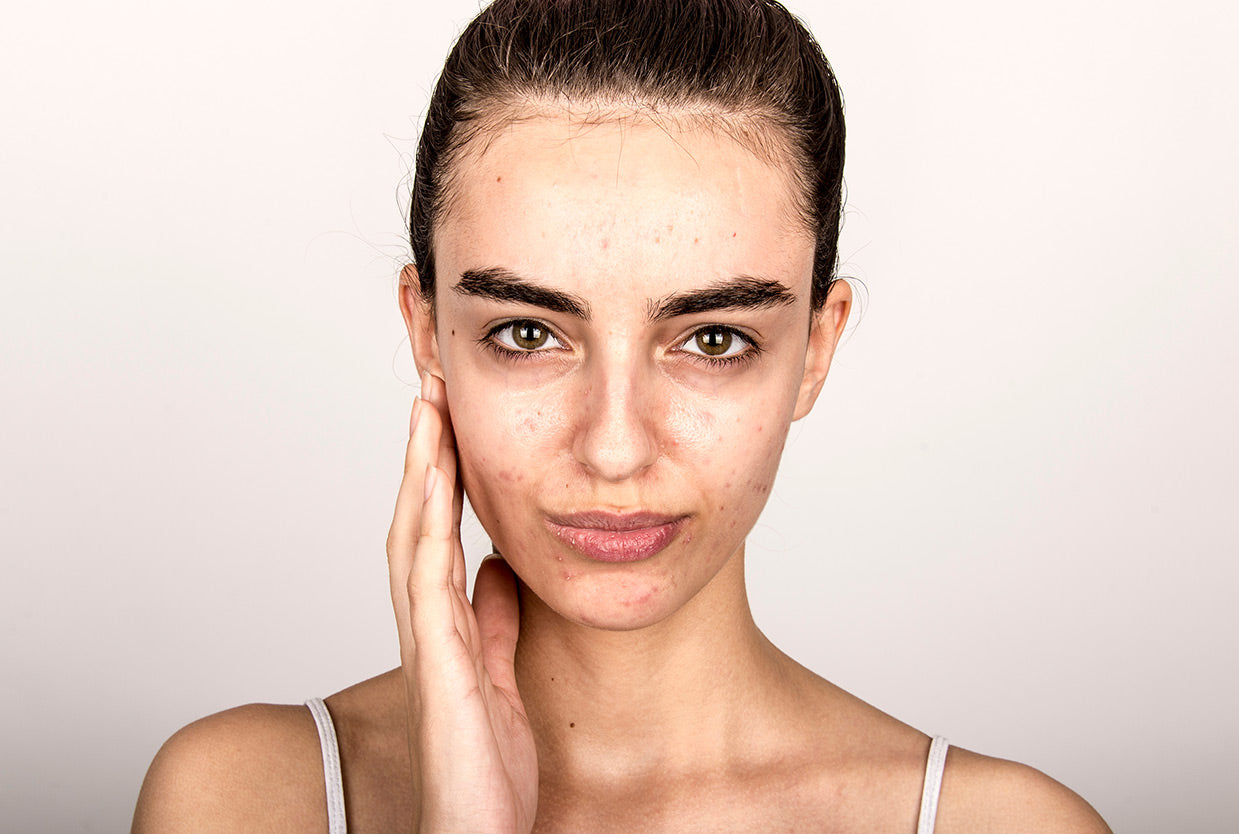What is acne? Acne is a medical term for pimples, blackheads, cysts etc. Acne most commonly appears on the face but can also affect the neck, chest, upper arms and back.
Acne does not affect the general state of health, but has a significant impact on the psyche of those affected.
Causes and development of acne
It used to be thought that it was due to diet and/or genetics. The causes are actually complex. Acne occurs when the skin's oil glands are out of balance. During puberty, this happens due to hormonal changes: the sebaceous glands begin to produce an oily substance. This substance is transported to the surface of the skin via the glands.
Sometimes the wall of the sebum ducts ruptures, so the liquid leaks into the surrounding tissues and the skin becomes red, swollen, inflamed - a pimple forms. Bacteria, present in large numbers in this fluid, aggravate the condition. Blackheads result from the glands becoming clogged with keratin and sebum. These can be easily squeezed out by the beautician or with practiced fingers.
The acid mantle (pH value) of our skin - how does it affect acne?
Our skin is one of the most important organs: it protects the body from the ingress of foreign, harmful substances (bacteria, fungi, germs), keeps important substances inside and regulates body temperature. Thousands of positive, protective bacteria live on it. The negative, harmful bacteria are removed from it through daily hygiene. In order to be able to cope well with its task, it must be elastic and firm and have a certain moisture and fat content.
With puberty, this film on our skin changes. Children's protective acid mantle is around pH 7, which means "neutral". When the body begins to produce more hair during puberty, the protective acid mantle changes and becomes more effective. In adults, it tends to be "sour" - a pH of around 5.5 - that's called skin-neutral. In this acidic environment, foreign bacteria have a hard time - that's why our protective acid mantle is such an important protective shield.
The pimples come - the washing mania begins
Adolescents now often tend to degrease the skin too much with cleaning products, which in turn encourages the body to produce even more fat in order to be able to protect itself better. This spiral – more cleansing – more fat production – also throws the hormone system out of balance. This is usually only the first step in acne, as many acne problems have developed over a long period of time and require further treatment.
One of the most important things you can do to prevent juvenile acne or keep it as faint as possible is to cleanse your skin with a pH skin neutral (5.5) product. In addition, the cleaning products should contain little or no alcohol, as it dries. You should also avoid using sodium lauryl sulfate, which makes the surface of the skin soft and more permeable. One of the cheapest options for a facial cleanser is plain yogurt.
Conventional acne treatment methods
Many of the conventionally used acne preparations only limit the problem temporarily and do not help to reduce excessive fat production to a controlled level in the long term. After a long period of acne treatment, the skin often becomes thinner, more sensitive, highly sensitive, reddened, etc. We therefore ask you to think carefully about such a treatment and to find out more about the ingredients and their long-term effects on the skin. Likewise, a treatment with the so-called "apparative cosmetics" (sanding) and acid treatment (peeling) should be carefully considered, since massive peeling can damage the skin and make it thinner and sensitive.
It is also important to know that acne treatment is not short-term and must include the whole body or person. Causes such as improper diet, stress, unhealthy lifestyle habits, etc. must be considered in order to develop a comprehensive skin improvement program. A visit to a non-medical practitioner may be a useful addition in order to track down underlying causes.
What is the best way to care for my acne skin?
Less is more and quality pays off. The be-all and end-all is a good thorough but not drying out cleaning. A friend of my daughters uses Living Nature's Purifying Cleanser and the good cleaning alone has improved her skin. Then the skin needs moisture and moderate fat - like when drinking and eating. Gels ( Hydrating Toning Gel ) and hydrosols can get moisture on the skin. It is best to pay attention to the signs of the controlled natural cosmetics that no parabens, silicones or other undesirable ingredients are in the care. Regulating fats are e.g. B. Evening primrose, macadamia nut, avocado oil.
Why does skin need oil at all, you ask?
This protects the skin, preserves the moisture in the skin (which otherwise simply evaporates again due to wind and weather) and prevents the skin from excessively boosting sebum production. A light, balancing care ( Balancing Day Lotion ) is ideal. It is best to apply manuka oil/manuka honey to the inflamed areas. The essential manuka oil is particularly effective against acne-promoting bacteria. Manuka gel is a great care gel for the night. It contains both the manuka honey and the manuka oil. And depending on your skin type, make a clay mask to get excess oil out of your pores. The Halloysite clay from New Zealand is very fine and soft and extremely active. After the mask, the skin becomes calmer, smoother and more balanced.
Last but not least: give your skin time!
Even if it's unsightly, pimples and inflammation don't go away overnight. With proper care, however, you will notice a significant improvement after 4 weeks.
You are welcome to send us an e-mail with questions to info@cobicos.de or call 0871 9668516 to ask for care tips.


Leave a comment